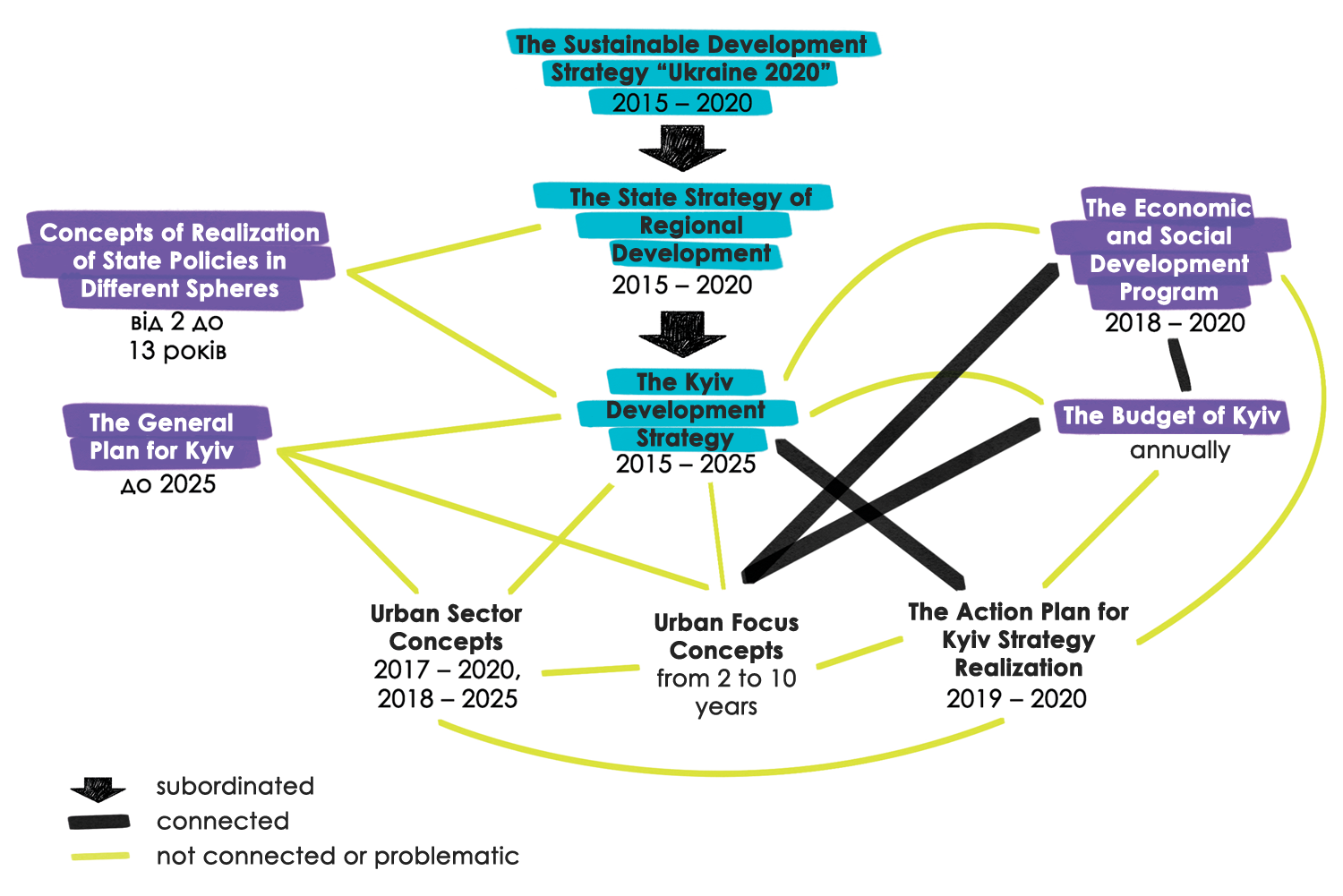We have analyzed the Kyiv Development Strategy Until 2025 and determined its place among other strategic documents of different levels, as well as studied the theoretical approaches and the basic legal and regulatory framework for the strategic development of regions and cities in Ukraine.
 The analysis was carried out by the think tank CEDOS within the framework of the “Think Tank Development Initiative for Ukraine”, which is conducted by the International Renaissance Foundation in partnership with the Open Society Initiative for Europe with the financial support of the Swedish Embassy in Ukraine.
The analysis was carried out by the think tank CEDOS within the framework of the “Think Tank Development Initiative for Ukraine”, which is conducted by the International Renaissance Foundation in partnership with the Open Society Initiative for Europe with the financial support of the Swedish Embassy in Ukraine.
The theoretical framework
Global state power decentralization has been in the process for the last 50 years. Part of the power goes from national authorities to local authorities, as well as to civil society and business. Urban strategies serve as a way of aligning the values, visions and goals of different interested parties and creating a shared vision of future urban policies. To achieve this, many different groups of residents get involved in the development of strategies: experts, activists, migrants, retirees, teachers, representatives of small, medium and large businesses, journalists, civil servants, artists, and others. Unlike the urban planning documentation, strategies are less formal, more flexible and clear for everyone.
Legal regulation
Unlike other cities and communities of the country, Kyiv has the status of a region. That is why the state has some requirements for its development strategy. The Law of Ukraine on the Principles of State Regional Policy regulates the creation of strategies for the regions, the Autonomous Republic of Crimea, Kyiv and Sevastopol. Detailed methods for their development was approved and recommended by the Ministry of Regional Development No. 79 on 31 March 2016. While preparing the current Kyiv Development Strategy, not all of the outlined recommendations were followed, such as the availability of gender-sensitive indicators or the impact on different population groups.
The law has no restrictions or regulations about what city strategies should include. Local self-governing communities are in charge of the strategic preparation, which they exercise at their discretion. This is the reason why not all the region centers currently have development strategies. However, there are some methodological guidelines for the development of JTCs’ strategies, approved by the Ministry of Regional Development No. 75 on 30 March 2016.
Both techniques recommend conducting public discussions when developing strategies. However, they don’t specify what kind of discussions we should opt for and who should be involved.
Recommendations:
-
To encourage cities and communities to develop their strategies. For example, through financing development projects and regional budgets only when the strategy is ready.
-
To develop and approve recommendations to develop strategies for all the cities and communities that take into account specific localities of different sizes.
-
To develop a monitoring system to evaluate and promote quality while preparing development strategies for the regions, cities and communities.
-
To take into account the needs and interests of different social groups according to the recommended formats while preparing development strategies. To attract more people: not only the representatives of business, the scientific environment and COs but also activists and residents.

Methods of strategy development
While preparing the current Kyiv Development Strategy, the only way to engage civil society was through an online survey, which was taken by 16 community organizations and businesses. This participation method provides very limited opportunities to involve different interested parties and social groups in strategy development. While preparing the development strategy of Kharkiv, though, 700 city residents took part in public opinion polls, 11 roundtables and focus groups. While preparing the Concept of integrated development of Podilskyi district, 6 workshops with stakeholders, as well as 9 discussions with residents in 3 waves with 303 participants were conducted.
Recommendations:
To take into account the needs of as many interested parties and social groups as possible and develop a fair strategy, we should use different engagement tools.
Our tips on participation mechanisms could be found here: http://bit.ly/tips_cooperation
The place of the strategy among other development documents
The Kyiv Development Strategy and the related documents contain some inconsistencies in terms, indicators and interconnections. For example, the Economic and Social Development Program for 2018-2020 repeats almost all of the 2025 Development Strategy goals and objectives that cannot be implemented in three years. All urban focus programs require several times more money than they currently have. The Economic and Social Development Program keeps providing for expenditures on projects that have not been implemented for more than five years.

Recommendations:
-
To agree on strategy implementation documents and set the timing.
-
Given scarce resources, we should set the goals, actions and directions using feasible and realistic implementation timing.
-
To establish a unified system of development and interrelated indicators in documents of different levels and time intervals.
The content of the strategy
The current Kyiv Development Strategy was created with the support of the Cities Alliance. To prepare urban development strategies, the organization recommends addressing poverty and ways to overcome it as one of its cross-cutting topics. The Kyiv Development Strategy, though, mentions poverty as an indicator of the social support and assistance sector only once, whereas economic inequality is not mentioned at all.
The strategy has three goals: 1) improving economic competitiveness, 2) increasing the life comfort of the residents, 3) preserving the historical identity and developing a culture. These targets are measured by the six indicators. Three of the six indicators are internationally ranked by WB Doing Business, EIU Global Liveability Ranking and Euromonitor Top 100 City Destinations Ranking.
Some methodological weaknesses question the validity of these ratings in terms of data on the implementation of the City Development Strategy. WB Doing Business measures the ease of doing business and the deregulation of the economy, including tax cuts and reduced corporate social responsibility. This rating prioritizes investors in conflict situations with public and labor interests. It contradicts one of the Strategy’s priorities: “Sustainable development is the balance of economic, social and environmental components”. A few years ago, the EIU Global Liveability Ranking called Kyiv the city with one of the worst life quality because of the outbreak of hostilities in the Donbas, which hardly reflects the real situation in the city. The Top 100 City Destinations Ranking by Euromonitor measures the tourist attractiveness, although the experience of major tourist cities in the world shows that increased tourism is a threat to cultural identity.
Another problem is that many pressing issues of the city are not or hardly mentioned in the strategy. In particular:
-
uncontrolled spot-building without the necessary infrastructure;
-
migration, in particular, commuting, external and internal, which leads to the difference between the official and the real population of the city;
-
prevention of and adaptation to climate change; transition to renewable energy sources;
-
leisure: a reduced number of non-commercial spaces available for self-development and leisure.
Recommendations:
-
To take into account poverty and economic inequality as a cross-cutting topic of the strategy.
-
To use valid indicators that measure progress towards a specific strategic goal.
-
To include important and relevant issues of the city in the strategy.
Support Cedos
During the war in Ukraine, we collect and analyse data on its impact on Ukrainian society, especially housing, education, social protection, and migration









